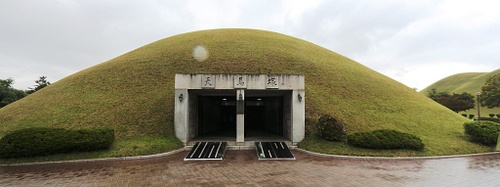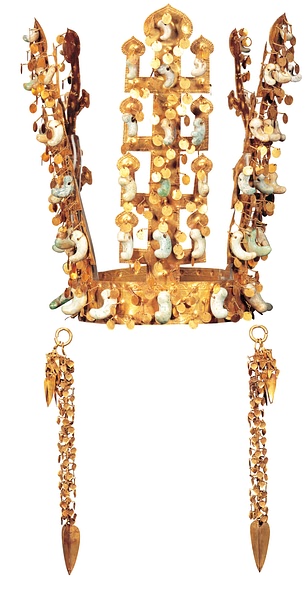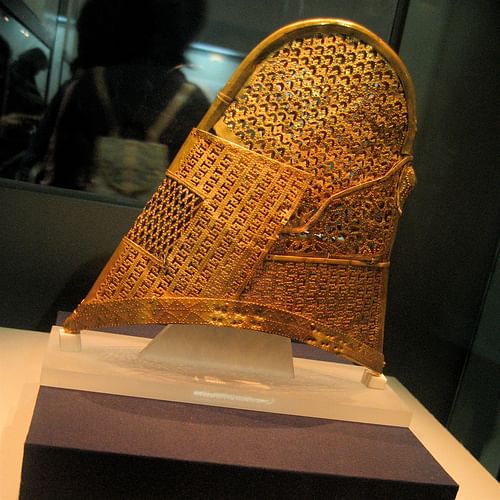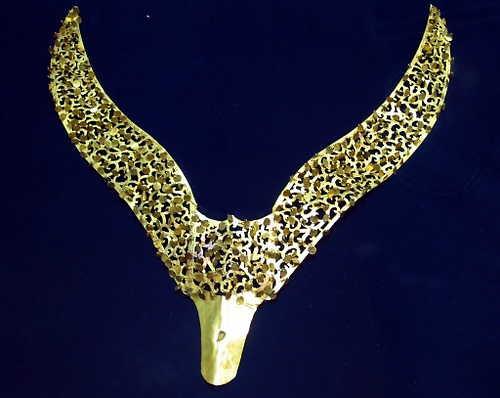Blue Glass Carafe With Ce Under a Crown
Cheonmachong is a 5-6th-century CE royal tomb of the ancient Silla kingdom of Korea located at the Daereungwon Tomb Complex in Gyeongju. It is popularly known as the 'Heavenly Horse Tomb' because of a painting of that animal on a birch-bark saddle-flap found within it. There were over 140 other treasures inside which included a magnificent gold crown, gold jewellery, a gold girdle, and a blue glass cup. Several items from the tomb feature on the official list of National Treasures of Korea.
Tomb Design
The tomb was excavated in 1973 CE at Gyeongju the former capital of the Silla kingdom then known as Geumseong or Seorabol. The Silla kingdom ruled the south-eastern portion of Korea between the 1st century BCE and 7th century CE. It would then go on to control the whole peninsula from 668 to 935 CE. Unlike in some other Silla mound tombs, there is no inscription plaque inside it to indicate exactly who the occupant was, but the richness of the artefacts within it and the presence of a gold crown would suggest it is the tomb of a Silla king. The tomb chamber is wood-lined and was covered in a stone mound with layers of clay set between the stones to make the tomb waterproof. Then the whole was covered in an earth mound, leaving no access point. This meant that the tomb did not suffer looting like many other Korean tombs of the Three Kingdoms period which had horizontal entrance passages. The tomb measures 12.7 metres in height and has a diameter of 47 metres.
The Gold Crown
The gold crown found in the tomb, like those from other Silla tombs, is composed of three parts which may have been intended to be worn all together. However, their location in three separate parts of this tomb may indicate that was not the case. The three elements are a diadem, gold cap, and wing-like appendages, presumably to be fitted into the cap. It is not clear whether the crown was meant to be worn, with some scholars suggesting it too delicate and others pointing out wear and tear marks on them which suggest they were used by the occupant when alive.

Cheonmachong ('Heavenly Horse Tomb')
The diadem is fitted with tall upright antlers (at the sides) and tree-like formations with U-shaped branches (at the front), which indicate a link with Scytho-Siberian shamanism. Made of thin pieces of cut sheet-gold they are embellished with granulation, punched dots, rivetting, filigree, and suspended disks or spangles. The crown is 32.5 cm high and is the most lavishly decorated of all the Silla crowns so far found. It has pendants of twisted gold ending in 58 crescent-shaped jade pendants known as gogok in Korean and very similar to those found in ancient Japan where they are called magatama; they symbolise new life. Two gold chain pendants hang from either side of the crown and end in a three-dimensional pointed-leaf shape. They both have leaf-shaped spangles and an extra addition of gold bunched leaves and spangles at the top much like Silla earrings in design. The crown is number 188 on the official list of National Treasures of Korea.

Silla Gold Crown from Cheonmachong
The gold cap, another National Treasure (no. 189), is around 18 cm in height and made from four separate gold sheets which display various intricate openwork patterns. The sheets are joined together by gold rivets and wiring while the rim has decorative punched holes. The wing-like parts of the ensemble, two individual pieces, may represent bird's wings which were potent symbols of Korean shamanism as they symbolised flight in the spiritual world. One wing is made from three gold sheets, measures 45 cm across, and is decorated with over 400 tiny spangles individually attached with gold wire. The second wing piece resembles an angel with spread wings, measures 21.5 x 22 cm, and is similarly decorated with spangles and embossed circles along its edges.

Gold Silla Cap
The Heavenly Horse
Horses had long been of importance in ancient Korean culture. Traditionally the peninsula was considered to have been first settled by horse-riders from the north, and many tombs contain horse trappings. Horses were also an export to Korea's major trading partner China over the centuries. A horse was sacrificed with the king of this tomb and a birch-bark flap on its saddle is painted with a figure of a white winged horse which has given the tomb its popular name of the 'Heavenly Horse Tomb'. The horse is painted in full gallop with flaring mane and tail. It also has curious crescent-shaped markings on its body which some scholars link to inlaid jades from Scythia. It is one of the earliest paintings of ancient Korea. Other saddle flaps in the tomb, carefully stored in a wooden chest, are similarly painted but this time with horsemen and one with a phoenix.

Gold Silla Crown Ornament
Other Treasures
The occupant of the tomb was placed in a wood coffin which was laid on a stone platform. Inside was a sword, the gold diadem of the crown, and the body wore gilt-bronze openwork shoes and various jewellery items – earrings, rings, bracelets, and a magnificent gold girdle. The girdle, another National Treasure (no. 190), measures 125 cm and has 13 pendants, the longest being 73.5 cm long. The belt has dragon carvings decoration and consists of 44 thin joined gold plates with a buckle and tongue at each end. The gold pendants are miniature representations of tools and items perhaps worn by state officials, a tradition probably based on the practice of nomadic tribes-people wearing real tool belts. The pendants include tweezers, a small knife, two writing tablets, a fish, a perfume bottle, two jade gogok, and a weight. Finally, outside the coffin and stored in a chest were various horse trappings, bronze bowls and cups, glass beads, lacquer work, and pottery.
This content was made possible with generous support from the British Korean Society.
This article has been reviewed for accuracy, reliability and adherence to academic standards prior to publication.
Source: https://www.worldhistory.org/Cheonmachong/
0 Response to "Blue Glass Carafe With Ce Under a Crown"
Post a Comment